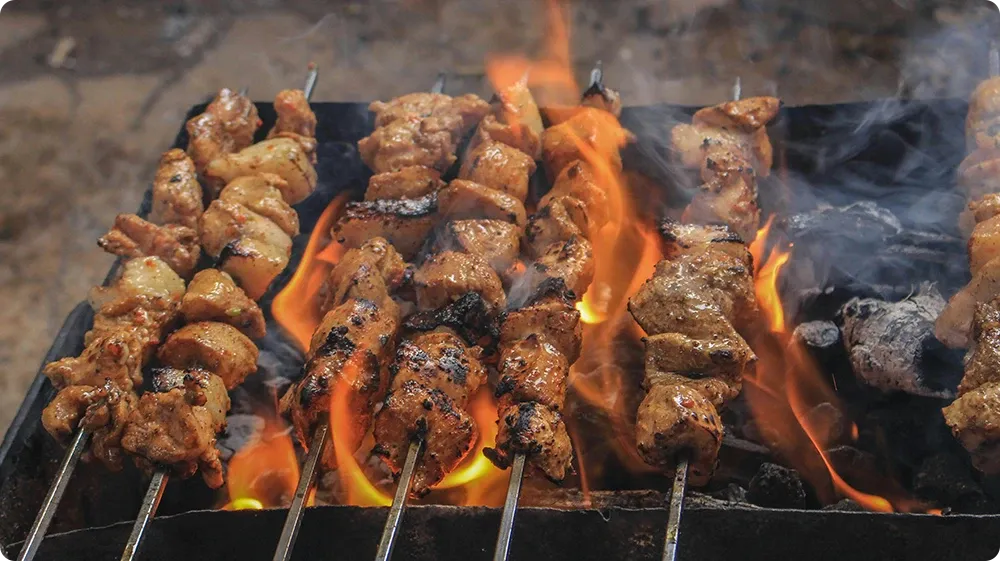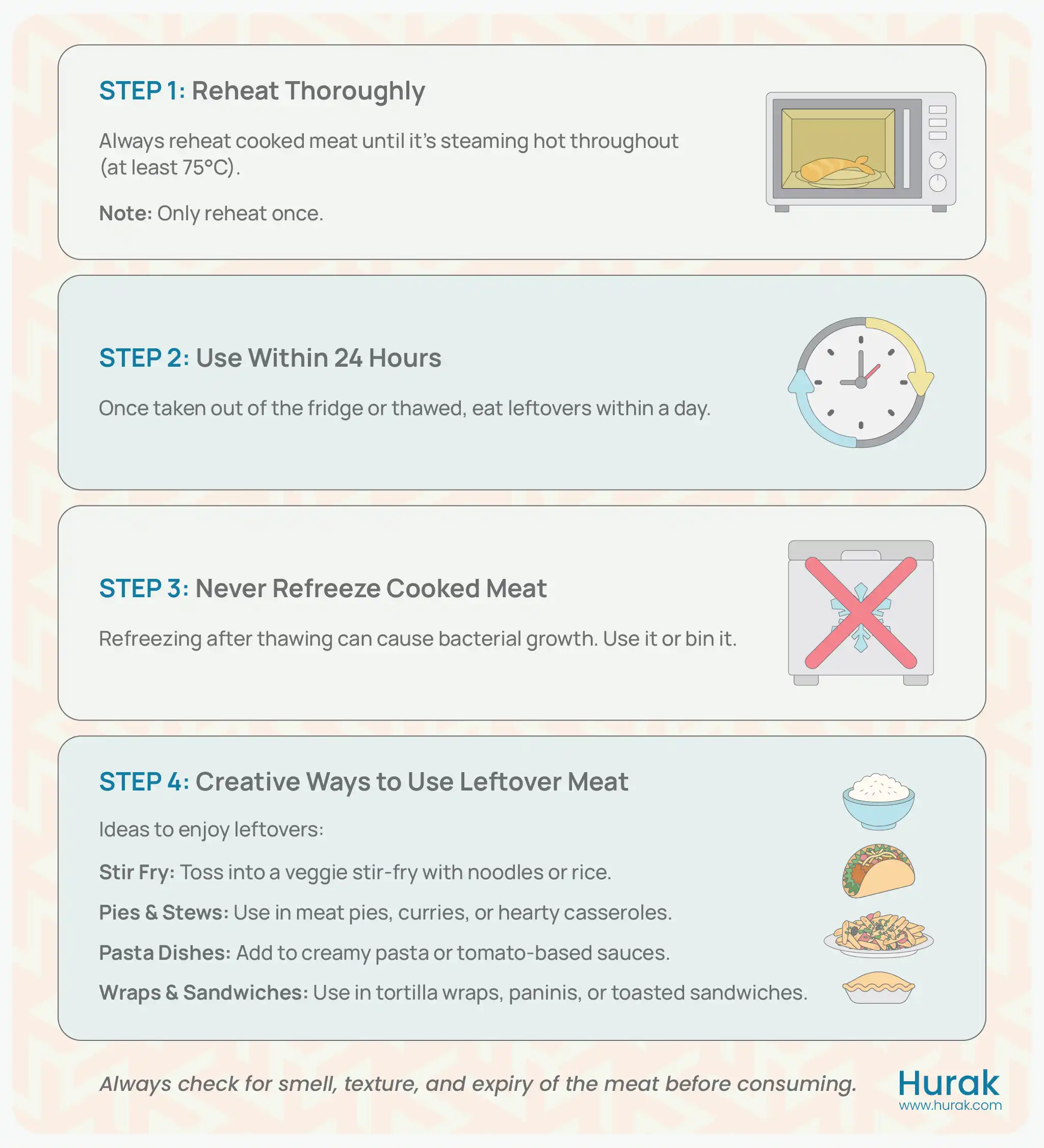Whether it’s roast beef from Sunday dinner or leftover chicken curry, cooked meat has a short life in the fridge. If stored too long, cooked meat can pose a risk of food poisoning, even when it appears and smells normal.
In this article, we’ll explain exactly how long different types of cooked meat can stay chilled safely, how storage methods affect freshness, and when it’s best to freeze or throw it away.
Let’s start by understanding what exactly falls under “cooked meat” — it’s broader than you might think.
What Counts as Cooked Meat?
When we say “cooked meat,” we’re referring to any meat product that has already been cooked and is ready to eat without further preparation. This includes food you’ve made at home as well as pre-cooked items bought from a shop or takeaway.
Here are some common examples of cooked meat:
- Home-cooked meat – Roasted chicken, grilled lamb chops, fried beef mince, baked pork, etc.
- Pre-cooked or ready-to-eat meats – Rotisserie chicken, cooked ham, sliced deli meats, and hot counter items.
- Cooked processed meats – Sausages, bacon, frankfurters, meatballs, and cooked salami.
- Mixed dishes containing cooked meat – Stews, curries, pasta bakes, casseroles, meat pies, and lasagne.
All of the above fall under the umbrella of cooked meat — whether prepared from scratch, pre-packed, or bought hot and ready to eat.
As meat comes under high-risk food, if you plan to store cooked meat after it’s been prepared, there’s a time limit to how long it stays safe. It also needs to be kept in the fridge or freezer under the right conditions to prevent cross-contamination.
Now that we’ve clarified what cooked meat includes, let’s look at how it should be cooked in the first place to ensure it’s safe to store.
How Should Meat Be Cooked to Ensure It’s Safe?
Proper cooking is the first and most critical step in making sure meat is safe to eat and store. Undercooked meat can still contain harmful bacteria such as Salmonella, E. coli, or Listeria, which can cause foodborne illnesses even if the meat looks done on the outside.
To ensure meat is fully cooked:
- Use a food thermometer and check the internal temperature. For most cooked meats, it should reach at least 75°C in the thickest part.
- Juices should run clear, not pink or red, especially with poultry.
- Stir or turn meat during cooking to avoid cold spots, particularly in microwave or oven dishes.
Cooking meat thoroughly helps prevent bacterial growth in the first place — a crucial step if you plan to store leftovers. It also supports longer-lasting results when using food preservation methods, such as refrigeration or freezing.
In the UK, the temperature danger zone ranges from 8°C to 63°C – a range in which bacteria can multiply rapidly and increase the risk of foodborne illness.
To keep cooked meat safe, ensure it cools quickly and is stored at a temperature below 5°C or above 63°C, depending on when you plan to eat it.
How Long Does Cooked Meat Last in the Fridge and Freezer?
The Food Standards Agency (FSA) recommends that cooked meat, including poultry, red meat, and processed meat, should be eaten within three days of the day it’s cooked or opened.
That means the day of cooking plus two more days. After that, it should either be thrown away or frozen before the three days are up.
Cooked Meat Shelf Life: UK Guidelines
| Cooked Meat Type | Fridge (≤5 °C) | Freezer (≤ –18 °C) |
| All cooked meats (chicken, lamb, beef, pork, sausages, etc.) | Eat within 3 days (day of cook + 2) | Safe for up to 3 months if frozen before day 3 |
| Meat-based stews, casseroles, or curries | Eat within 3 days | 2–3 months |
| Pre-packed cooked meats (opened | Eat within 3 days of opening | Up to 1 month if frozen before the use-by date |
Note: Follow storage instructions on packaging, including the Use-By and Best-Before dates.
Check out our article on How Long Can You Freeze Food for detailed freezer storage guide
If you’ve stored your cooked meat in the freezer, you’ll need to defrost it properly to keep it safe to eat.
Let’s look at the right ways to do it.
Defrosting Cooked Meat: What You Need to Know
When you freeze cooked meat, defrosting it safely is just as important as how you stored it. Incorrect defrosting can lead to the growth of harmful bacteria.
Here’s how to do it properly:
Option 1: In the Fridge (Recommended)
- Transfer the cooked meat from the freezer to the bottom shelf of your fridge.
- Place it in a sealed container or on a plate to catch any moisture.
- Let it defrost overnight or for several hours, depending on portion size.
- Once fully thawed, you must eat it within 24 hours.
- Never refreeze previously frozen cooked meat after defrosting.
Option 2: In the Microwave (Only If You’re Reheating Immediately)
- Use the defrost setting or low power setting
- Reheat thoroughly until the food is steaming hot throughout.
- Only use this method if you plan to eat the meat immediately after defrosting.
- Do not refreeze after microwaving.
For a detailed guide, refer to our article on defrosting cooked food in the microwave.
Why This Matters
Cooked meat, once frozen, should be treated like fresh meat when defrosted. Bacteria can multiply quickly if they’re kept too long at room temperature or if they’re not reheated thoroughly.
Also note:
- Reheating cooked meat is safe, provided it has been stored, defrosted, and reheated properly.
- Check out our article on How to Reheat Food Safely More Than Once
- When in doubt, it’s safest to discard the meat.
But whether you’ve defrosted it or kept it chilled, cooked meat won’t last forever, and the risks of holding it too long are real.
Let’s understand what happens if you store cooked meat for too long.
What Happens If You Eat Cooked Meat That’s Been in the Fridge Too Long?
Leaving cooked meat in the fridge beyond the recommended 3-day limit can pose serious health risks.
Potential Risks:
- Bacterial growth – Harmful bacteria like Listeria and Salmonella can multiply.
- Spoilage – Even if it looks or smells fine, toxins may already be present.
- Food poisoning – Nausea, vomiting, diarrhoea, stomach cramps, and even hospitalisation in severe cases.
If cooked meat smells off, has a slimy texture, or you’re unsure how long it’s been in the fridge, it’s always safer to discard it.
To make the most of cooked meat’s short shelf life, it’s important to store it properly and avoid early spoilage.
How to Store Cooked Meat Safely
Storing cooked meat properly is just as important as cooking it thoroughly. Even a short lapse in temperature control or hygiene can increase the risk of contamination and spoilage.
Here’s how to store cooked meat safely:
- Cool food quickly – Ideally within 1–2 hours after cooking. Avoid leaving meat out at room temperature.
- Use shallow containers – These help meat cool evenly and faster.
- Store in sealed, airtight containers – Prevents exposure to air and bacteria.
- Label with the date – Always write the storage date and type of meat to avoid confusion later.
- Keep your fridge below 5°C – Use a thermometer to check. Don’t rely on guesswork.
- Keep cooked meat separate from raw meat – This avoids cross-contamination. Store cooked items on the top shelf.
Need help keeping things organised? Check out our guide on how to organise your fridge for food safety.
Store Cooked Food Safely — Whether at Home or on the Job
Storing and preserving food the right way isn’t just important for households — it’s critical for catering professionals, manufacturers, and retail staff too. If you handle food, understanding proper storage, labelling, and hygiene is essential to keep customers safe and stay compliant with UK law.
Hurak offers certified Level 2 Food Hygiene and Safety Courses for all major industries:
Level 2 Food Hygiene for Catering
Level 2 Food Hygiene for Manufacturing
Level 2 Food Hygiene for Retail
Enrol now to build safer food habits at work.
How to Tell If Cooked Meat Has Gone Bad
Even within its storage time, cooked meat can still spoil if not handled or stored properly. Spotting the signs early can protect you from foodborne illness.
Signs to Watch Out For:
- Unpleasant smell – A strong, sour, or “off” odour is the clearest warning.
- Slimy or sticky texture – This often indicates bacterial growth.
- Discolouration – Greyish or green patches mean it’s no longer safe to eat.
- Unusual taste – If the flavour seems off, do not consume the meat.
Now, if your cooked meat still looks and smells fine and is within its safe storage period, you might be wondering: What’s the best way to use it?
How to Use Leftover Cooked Meat Safely
Leftover cooked meat doesn’t have to go to waste — in fact, with the proper handling and a bit of creativity, it can become the base of your next delicious meal.
From quick stir-fries to comforting pies, there are plenty of safe, tasty ways to use it up before it expires.
Here’s a quick guide to using leftover cooked meat safely and creatively
Appropriately handled, leftovers can help reduce waste, save money, and make meal prep a whole lot easier.
Conclusion: Make Every Bite Safe
Cooked meat may seem harmless once it’s properly chilled and stored in the fridge, but it has a short shelf life and needs the same care and attention as raw meat.
Let’s say you batch-cooked some roast beef for Sunday dinner. You stored the leftovers properly, but they remained in the fridge until Thursday, exceeding the recommended storage time. At that point, the meat is no longer safe to eat, regardless of appearance.
Had you labelled the container and eaten it by Tuesday, it could’ve become a tasty sandwich filling or part of a beef stir-fry.
Knowing how long cooked meat lasts and how to store it properly makes everyday food handling safer and more efficient.
Whether you manage a kitchen or cook at home, adopting these practices ensures food safety and reduces waste, one meal at a time.
Want to Improve Food Safety Standards at Work?
Learn how to store, handle, and manage food safely with Hurak’s CPD-recognised
FAQs
How long does cooked meat last in the fridge (UK)?
Cooked meat lasts for up to 3 days in the fridge when stored at 5°C or below. This includes the day it was cooked, plus two more days. After this point, it should be eaten, frozen, or discarded.
Can you eat cooked meat after 5 days in the fridge?
No, it’s not recommended. Even if there are no visible signs of spoilage, bacteria like Listeria can multiply over time. After 3 days, cooked meat becomes unsafe and should be thrown away.
How long can you keep cooked meat in the freezer?
You can freeze cooked meat for up to 2–3 months. It should be stored in an airtight container or freezer-safe bag. Always label and date it before freezing.
Can you reheat cooked meat more than once?
Yes, but it’s safest to reheat only once. Reheat thoroughly until the food is steaming hot throughout (75°C). Never reheat meat that’s been left out for more than two hours or has already been reheated.
How do I know if cooked meat has gone bad?
Look out for:
- Unpleasant or sour smell
- Slimy texture
- Unusual discolouration
If in doubt, throw it out — even if it’s within the “safe” period.
What’s the safest way to store leftover cooked meat?
- Cool it quickly (within 2 hours of cooking)
- Store in sealed containers
- Place it in the coldest part of the fridge (≤5°C)
- Label with the date cooked
For longer storage, freeze portions in airtight containers.





